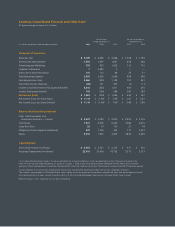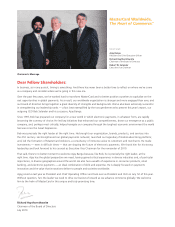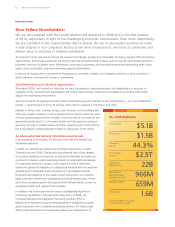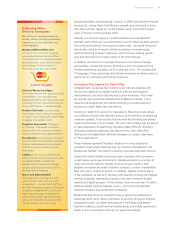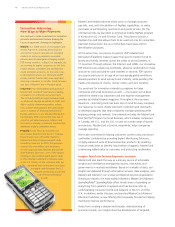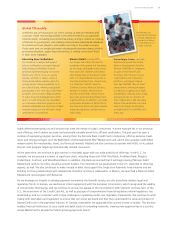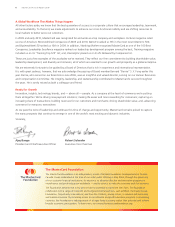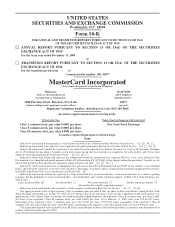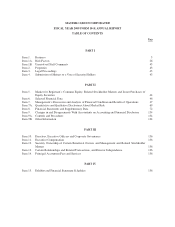MasterCard 2009 Annual Report Download
Download and view the complete annual report
Please find the complete 2009 MasterCard annual report below. You can navigate through the pages in the report by either clicking on the pages listed below, or by using the keyword search tool below to find specific information within the annual report.
A time of change.
A world of opportunities.
MasterCard Annual Report 2009
Table of contents
-
Page 1
A time of change. A world of opportunities. MasterCard Annual Report 2009 -
Page 2
... report in U.S. dollars For the Years Ended December 31 (In millions except per-share and operating data) 2009 2008 2007 For the Three Months Ended March 31 2010 2009 Statement of Operations Revenues, Net General and Administrative Advertising and Marketing Litigation Settlements Depreciation... -
Page 3
...our leadership ranks - a fact best exempliï¬ed by the two gentlemen who present this year's report, our outgoing CEO Bob Selander and his successor, Ajay Banga. Since 1997, Bob has prepared our company for a new world in which electronic payments, in whatever form, are rapidly becoming the currency... -
Page 4
... (IPS), a MasterCard-engineered issuer processing platform designed to provide global customers with a complete processing solution. IPS helps create differentiated products and services and allows quick deployment of Key 2009 Highlights Net Revenue Net Income Operating Margin Gross Dollar Volume... -
Page 5
... MasterCard MarketPlace. This exciting online shopping destination powered by Next Jump offers discounts and privileges from thousands of merchants across the United States. payment portfolios across banking channels. In 2009, Swiss Bankers Prepaid Services Ltd., whose Travel Cash Maestro prepaid... -
Page 6
... allowed banks and mobile network operators in emerging markets to advance payments via mobile phones and included game-changing mobile P2P money transfers. In Brazil, for example, we are working to enable consumers to link their mobile phones to MasterCard and Maestro credit and debit accounts. At... -
Page 7
... United Nations Development Fund for Women (UNIFEM) in Singapore. As part of the MasterCard Purchase with Purposeâ„¢ social responsibility and citizenship platform, we helped stage a two-day UNIFEM "Buy to Save" charity event, offering shoppers a collection of gently used, highend designer clothing... -
Page 8
...; and BusinessWeek 50 ranked us 10th in 2009. In addition, Working Mother recognized MasterCard as one of the 100 Best Companies; Leadership Excellence magazine ranked our leadership development program among the best; Training magazine included us on its "Training Top 125" list; and, DiversityInc... -
Page 9
... is a shell company (as defined in Rule 12b-2 of the Act). Yes ' No à The aggregate market value of the registrant's Class A common stock, par value $.0001 per share, held by non-affiliates (using the New York Stock Exchange closing price as of June 30, 2009, the last business day of the registrant... -
Page 10
-
Page 11
...Matters and Issuer Purchases of Equity Securities Item 6. Selected Financial Data Item 7. Management's Discussion and Analysis of Financial Condition and Results of Operations Item 7A. Quantitative and Qualitative Disclosures About Market Risk Item 8. Financial Statements and Supplementary Data Item... -
Page 12
[THIS PAGE INTENTIONALLY LEFT BLANK] -
Page 13
... brands, we also establish and enforce rules and standards surrounding the use of our payment card network. MasterCard generates revenue by charging fees to our customers for providing transaction processing and other payment-related services and assessing our customers based on the dollar volume... -
Page 14
... over the number of transactions processed in 2008. Gross dollar volume ("GDV") on cards carrying the MasterCard brand as reported by our customers was approximately $2.5 trillion in 2009, a 3.3% decrease in U.S. dollar terms and a 1.4% increase in local currency terms over the GDV reported in 2008... -
Page 15
... transactions. The primary general purpose card brands include MasterCard, Visa®, American Express®, JCB®, Diners and Discover®. Historically, these brands-including MasterCard-were principally associated with "pay later" (credit or charge) cards in the United States and other major markets... -
Page 16
...issuer pays the acquirer an amount equal to the value of the transaction minus any interchange fee and posts the transaction to the cardholder's account. Our rules generally guarantee the payment of transactions using MasterCard-branded cards and certain transactions using Cirrus and Maestro-branded... -
Page 17
... the merchant discount. Issuers may also charge cardholders fees for the transaction, including, for example, fees for extending revolving credit. As described below, we charge issuers and acquirers transaction-based and related fees and assessments for the services we provide them. Interchange fees... -
Page 18
... to develop customized programs and services. Settlement. Once transactions have been authorized and cleared, MasterCard helps to settle the transactions by facilitating the exchange of funds between parties. Once clearing is completed, a daily reconciliation is provided to each customer involved in... -
Page 19
... lines to provide our customers with a view of information that can help them customize their products and programs. We continue to develop opportunities to further enhance our IPS offerings and global presence. Mobile Payments Gateway. In November 2009, MasterCard introduced the Mobile Payments... -
Page 20
...table below provides information regarding the GDV for all MasterCard-branded cards (excluding Cirrus and Maestro) and for both MasterCard credit and charge card programs and MasterCard debit programs in the United States and in all of our other regions for the years ended December 31, 2009 and 2008... -
Page 21
... in connection with these programs. Consumer Credit and Charge Programs. MasterCard offers a number of consumer credit and charge ("pay later") programs that are designed to meet the needs of our customers. For the year ended December 31, 2009, our consumer credit and charge programs generated... -
Page 22
... 31, 2009. MasterCard Global ATM Solutions provides domestic (in-country) and cross-border access to cards allowing for varied types of transactions, including cash withdrawal (deposit accounts), cash advance (credit accounts), cash drawdown (prepaid accounts), balance inquiries, account transfers... -
Page 23
... contactless functionality in cards and other devices to enable MasterCard acceptance in low-value, high-volume merchant environments. MasterCard is also working to develop standards and programs that will allow consumers to conduct their financial transactions securely using a variety of new point... -
Page 24
... and customers to engage directly in brand programs, promotions and merchant offers, as well as provide relevant information on MasterCard products, services and tools. MasterCard has also introduced global and regional specific smart phone applications that provide consumers with on-the-go utility... -
Page 25
... 31, 2009, more than 70 million PayPass cards and devices were issued globally with acceptance at approximately 200,000 merchant locations worldwide. Additional Services. In addition, we provide research, marketing support and financial assistance to our customers and their marketing partners in... -
Page 26
... on developing merchant relationships and promoting acceptance at the point of sale. Cross-border volume fees: Cross-border volume fees are charged to issuers and acquirers based on the volume of activity on MasterCard and Maestro-branded cards where the merchant country and cardholder country are... -
Page 27
... are provided to certain MasterCard customers and are recorded as contra-revenue in the same period that performance occurs. Performance periods vary depending on the type of rebate or incentive, including commitments to the agreement term, hurdles for volumes, transactions or issuance of new cards... -
Page 28
...-branded transactions, which is calculated using the average daily card charges made during the quarter multiplied by the estimated number of days to settle, was approximately $26.4 billion as of December 31, 2009. Principal members participate directly in MasterCard programs and are responsible... -
Page 29
... MasterCard cards. We provide education programs and various risk management tools to help prevent fraud, including MasterCard SecureCode®, a global Internet authentication solution that permits cardholders to authenticate themselves to their issuer using a unique, personal code, and our Site Data... -
Page 30
... • End-to-End Payment Networks. Our competitors include operators of proprietary end-to-end payment networks that have direct acquiring relationships with merchants and direct issuing relationships with cardholders, such as American Express and Discover. These competitors have certain advantages... -
Page 31
... and acquiring financial institutions, and thereby replicating certain aspects of end-to-end payment networks. A number of our large customers, including Bank of America, Citibank, Barclays, HSBC, USAA and GE Money now issue American Express and/ or Discover-branded cards. See "Risk Factors-Business... -
Page 32
... and merchants; the acceptance base, reputation and brand recognition of payment cards; the success and scope of marketing and promotional campaigns; the quality, security and integrity of transaction processing; the relative value of services and products offered; regulation and local laws; 22 -
Page 33
... its authority to examine financial institutions' technology service providers. Examinations by the FFIEC cover areas such as data integrity and data security. In recent years, the U.S. federal banking regulators have adopted a series of regulatory measures affecting credit card payment terms and... -
Page 34
... cards for future credit risk and will have a significant effect on the pricing, credit allocation, and business models of most major credit card issuers. The new law could reduce credit availability, or increase the cost of credit to cardholders, possibly affecting MasterCard transaction volume... -
Page 35
... our customers and may consequently adversely affect transaction volumes and revenues. The Board of Governors of the United States Federal Reserve System has also recently adopted regulations regulating overdraft fees imposed in connection with ATM and debit card transactions. These regulations will... -
Page 36
... that acquirers charge merchants in connection with the acceptance of payment cards. Typically, interchange fees are paid by the merchant bank (the acquirer) to the cardholder bank (the issuer) in connection with transactions initiated with our payment system's cards. Interchange fees, including... -
Page 37
... have issued information requests and demands to MasterCard (and Visa) concerning points of sale acceptance rules and interchange setting practices. In the United Kingdom, in February 2007, the Office of Fair Trading commenced a new investigation of our current U.K. credit card interchange fees and... -
Page 38
.... A separate bill introduced in the House-"The Credit Card Interchange Fees Act of 2009"-prior to the Credit Card Fair Fee Act would, among other things, prohibit the inclusion of certain provisions in payment card network rules (e.g., honor all cards) and direct the U.S. Federal Trade Commission to... -
Page 39
... and adversely affect our revenue and profitability. As a result of the settlement agreement in connection with the U.S. merchant lawsuit in 2003, merchants have the right to reject our debit cards in the United States while still accepting other MasterCard-branded cards, and vice versa. See Note 21... -
Page 40
..., and business models of most major credit card issuers. Additional regulations include recently adopted regulations by the Board of Governors regulating overdraft fees imposed in connection with ATM and debit card transactions. Financial industry regulation, such as the proposed CFPA (passed by the... -
Page 41
... and information security in the jurisdictions in which we do business, and we and our customers could be negatively impacted by these regulations. For example, in the United States, we and our customers are respectively subject to Federal Trade Commission and banking agency information safeguard... -
Page 42
... potential changes in laws and regulations. Many of our financial institution customers, merchants that accept our brands and cardholders who use our brands have been directly and adversely impacted. MasterCard's financial results may be negatively impacted by actions taken by individual financial... -
Page 43
...American Express, Discover, private-label card networks and certain alternative payments systems, operate end-to-end payments systems with direct connections to both merchants and consumers, without involving intermediaries. These competitors seek to derive competitive advantages from their business... -
Page 44
...on the dollar volume of activity on cards carrying our brands. In order to increase transaction volumes, enter new markets and expand our card base, we seek to enter into business agreements with customers through which we offer incentives, pricing discounts and other support to customers that issue... -
Page 45
... all cross-border transactions using MasterCard, Maestro and Cirrus-branded cards and generate a significant amount of revenue from cross-border volume fees and transaction processing fees. Revenue from processing cross-border and currency conversion transactions for our customers fluctuates with 35 -
Page 46
... cardholders using cards that carry our brands. Each issuer determines these and most other competitive card features. In addition, we do not establish the discount rate that merchants are charged for card acceptance, which is the responsibility of our acquiring customers. As a result, our business... -
Page 47
... involving our brands account for a smaller share of all offline, signature-based debit transactions than they do credit or charge transactions. In addition, many of our competitors process a greater number of online, PIN-based debit transactions at the point of sale than we do, since our Maestro... -
Page 48
... several high-profile account data compromise events involving merchants and third party payment processors that process, store or transmit payment card data, which affected millions of MasterCard, Visa, Discover and American Express cardholders. As a result of such data security breaches, we may... -
Page 49
... the rapid technological developments in our industry to provide customers, merchants and cardholders with new and innovative payment programs and services, the use of our cards could decline, which could reduce our revenue and income or limit our future growth. The payment card industry is subject... -
Page 50
...amounts and other limits. The Company has completed four such voluntary conversion programs, including one program in 2009. After May 31, 2010, holders of our Class B common stock will have the option to convert all of their shares of Class B common stock into shares of Class A common stock on a one... -
Page 51
... we have adopted limited liability provisions that eliminate the personal liability of directors and the members of our European Board for monetary damages for actions taken as a director or member, with certain exceptions; and a vote of 80% or more of all of the outstanding shares of our stock then... -
Page 52
... of MasterCard or for us to cease to engage in the business of providing core network authorization, clearing and settlement services for branded payment card transactions. In addition, the holders of our Class M common stock have the right to elect up to three of our directors. Because shares of... -
Page 53
... of December 31, 2009, MasterCard and its subsidiaries owned or leased 98 commercial properties. We own our corporate headquarters, a 472,600 square foot building located in Purchase, New York. There is no outstanding debt on this building. Our principal technology and operations center is a 528,000... -
Page 54
... high and low sale prices for our Class A common stock for the four quarterly periods in each of 2009 and 2008, as reported by the New York Stock Exchange. At February 11, 2010, the Company had 42 stockholders of record for its Class A common stock. We believe that the number of beneficial owners is... -
Page 55
... to pay a quarterly cash dividend on our outstanding Class A common stock and Class B common stock. However, the declaration and payment of future dividends is at the sole discretion of our Board of Directors after taking into account various factors, including our financial condition, settlement... -
Page 56
...thereto included in Part II, Item 8. 2009 Year Ended December 31, 2008 2007 2006 (In thousands, except per share data) 2005 Statement of Operations Data: Revenues, net ...Total operating expenses ...Operating income (loss) ...Net income (loss) attributable to MasterCard ...Basic earnings (loss) per... -
Page 57
... been excluded to provide a comparison of the effective income tax rate associated with ongoing operations of the business. See "-Income Taxes" for a table which provides a reconciliation of the effective income tax rate excluding litigation settlements to the most directly comparable GAAP measure... -
Page 58
... year ended December 31, 2009. Our net revenues increased 2.1% in 2009, primarily due to increased transactions, pricing changes and increases in the volume of activity on cards carrying our brands, partially offset by approximately 1.8 percentage points relating to the U.S. dollar average exchange... -
Page 59
... potential changes in laws and regulations. Many of our financial institution customers, merchants that accept our brands and cardholders who use our brands have been directly and adversely impacted. MasterCard's financial results may be negatively impacted by actions taken by individual financial... -
Page 60
... global payments industry (such as premium/ affluent, quick-service/low value, commercial/small business, debit, prepaid and issuer and acquirer processor services), pursuing domestic processing opportunities throughout the world, enhancing our merchant relationships, expanding points of acceptance... -
Page 61
... effective for the Company resulting in the retrospective adjustment of EPS for prior periods. Data represents all transactions processed by MasterCard, including PIN-based online debit transactions, regardless of brand. The numbers were updated in 2009 to exclude a small number of certain processed... -
Page 62
... MasterCard's business model involves four participants in addition to us: cardholders, merchants, issuers (the cardholders' banks) and acquirers (the merchants' banks). Our gross revenues are typically based on the volume of activity on cards that carry our brands, the number of transactions... -
Page 63
... on developing merchant relationships and promoting acceptance at the point of sale. Cross-border volume fees: Cross-border volume fees are charged to issuers and acquirers based on the volume of activity on MasterCard and Maestro-branded cards where the merchant country and the cardholder country... -
Page 64
... listing to merchants. Cardholder services fees are for benefits provided with MasterCard-branded cards, such as insurance, telecommunications assistance for lost cards and locating automated teller machines. Consulting and research fees are primarily generated by MasterCard Advisors, the Company... -
Page 65
... Dollar For the Years Ended December 31, Increase (Decrease) 2009 2008 2007 2009 2008 (In millions, except percentages) Percent Increase (Decrease) 2009 2008 Domestic assessments ...Cross-border volume fees ...Transaction processing fees ...Other revenues ...Gross revenues ...Rebates and incentives... -
Page 66
...and research fees. In 2008 compared to 2007, there were increased fees for account and transaction enhancement services and cardholder service fees. • Rebates and incentives-Rebates and incentives increased 10.1% in 2009 and 11.0% in 2008. Rebates and incentives as a percentage of gross revenues... -
Page 67
... settlements, which is the most directly comparable GAAP measurement. Management believes this analysis may be helpful in evaluating ongoing operating expenses and allows for a more meaningful comparison between periods. For the year ended For the year ended Percent Percent December 31, 2009... -
Page 68
... that drive card acceptance and usage and facilitate our ability to successfully introduce new service offerings and access new markets globally. Our advertising and marketing strategy is to increase global MasterCard brand awareness, preference and usage through integrated advertising, sponsorship... -
Page 69
... of $1.8 billion. The charge is based on MasterCard's assumption that American Express will achieve certain financial performance hurdles. The quarterly payments will be in an amount equal to 15% of American Express' United States Global Network Services billings during the quarter, up to a maximum... -
Page 70
... primarily due to increased investments in data center equipment, capitalized software and leasehold and building improvements. Additionally, in 2009 the increase included depreciation on the Company's global technology and operations center, which was acquired under a capital lease arrangement. We... -
Page 71
... the years ended December 31, 2009 2008 2007 Dollar Dollar Dollar Amount Percent Amount Percent Amount Percent (In millions, except percentages) Income (loss) before income tax expense ...Federal statutory tax ...State tax effect, net of federal benefit ...Foreign tax effect, net of federal benefit... -
Page 72
... items, the Company believes that the calculation of the 2008 effective tax rate, excluding the impacts of the Discover Settlement and the American Express Settlement, will be helpful in comparing effective tax rates for 2009, 2008 and 2007. GAAP effective tax rate calculation 2009 2008 2007 (In... -
Page 73
... card network. We intend to continue to invest in our infrastructure to support our growing business and strategic initiatives. The auction rate securities ("ARS") market was illiquid as of December 31, 2009 and 2008 and therefore our ARS are classified as long-term available-for-sale securities... -
Page 74
... financial condition, settlement guarantees, operating results, available cash and anticipated cash needs. Credit Availability Moody's Investors Service assigned issuer credit ratings of A3 long-term and P-2 short-term with a stable outlook for MasterCard Incorporated on September 9, 2009. Standard... -
Page 75
... for future marketing, computer hardware maintenance, software licenses and other service agreements. Future cash payments that will become due to our customers under agreements which provide pricing rebates on our standard fees and other incentives in exchange for transaction volumes are not... -
Page 76
... include GDV or GEV, transactions, issuance of new cards, launch of new programs or the execution of marketing programs. In addition, certain customer agreements include prepayment of rebates and incentives. Amortization of prepayments and other assets may be on straight-line basis over the life of... -
Page 77
...the Company will have offsetting tax deductions or tax credits. If our business plans change or our future outcomes differ from our expectations, U.S. income tax expense and our effective tax rate could increase or decrease in that period. We record tax liabilities for uncertain tax positions taken... -
Page 78
... value of prepaid customer and merchant incentives was $445 million at December 31, 2009. We utilized a weighted income and market approach for determining the fair values of our reporting units. Our significant valuation judgments included forecasting cash flows, selection of discount rates... -
Page 79
... rates, foreign currency exchange rates and equity price risk. We have limited exposure to market risk from changes in interest rates, foreign exchange rates and equity price risk. Management establishes and oversees the implementation of policies, which have been approved by the Board of Directors... -
Page 80
...Fair Value Commitments to purchase foreign currency ...Commitments to sell foreign currency ... $16 45 $- - $- 66 $- - Our settlement activities are subject to foreign exchange risk resulting from foreign exchange rate fluctuations. This risk is limited to the typical one business day timeframe... -
Page 81
...At December 31, 2009, we have a credit facility which provides liquidity in the event of material member settlement failures, settlement service operations and other operational needs. This credit facility has variable rates, which are applied to the borrowing based on terms and conditions set forth... -
Page 82
... FINANCIAL STATEMENTS Page MasterCard Incorporated As of December 31, 2009 and 2008 and for the years ended December 31, 2009, 2008 and 2007 Management's Report on Internal Control Over Financial Reporting ...Report of Independent Registered Public Accounting Firm ...Consolidated Balance Sheets... -
Page 83
... designed to provide reasonable assurance regarding the reliability of financial reporting and the preparation of financial statements for external reporting purposes in accordance with accounting principles generally accepted in the United States of America. Because of its inherent limitations... -
Page 84
... Reporting. Our responsibility is to express opinions on these financial statements, and on the Company's internal control over financial reporting based on our integrated audits. We conducted our audits in accordance with the standards of the Public Company Accounting Oversight Board (United... -
Page 85
... BALANCE SHEETS December 31, 2009 December 31, 2008 (In thousands, except share data) ASSETS Cash and cash equivalents ...Investment securities, at fair value: Available-for-sale ...Municipal bonds held-to-maturity ...Accounts receivable ...Income taxes receivable ...Settlement due from customers... -
Page 86
MASTERCARD INCORPORATED CONSOLIDATED STATEMENTS OF OPERATIONS For the Years Ended December 31, 2009 2008 2007 (In thousands, except per share data) Revenues, net ...Operating Expenses General and administrative ...Advertising and marketing ...Litigation settlements ...Depreciation and amortization ... -
Page 87
... of business, net of cash acquired ...Investment in affiliates ...Other investing activities ...Net cash provided by (used in) investing activities ...Financing Activities Purchase of treasury stock ...Payment of debt ...Dividends paid ...Exercise of stock options ...Tax benefit for share based... -
Page 88
... of new tax accounting standard ...21,175 21,175 Cash dividends declared on Class A and Class B common stock, $0.60 per share ...(81,571) (40,166) Share based payments ...58,213 - Stock units withheld for taxes ...(11,334) - Tax benefit for share based compensation ...15,430 - Purchases of treasury... -
Page 89
MASTERCARD INCORPORATED CONSOLIDATED STATEMENTS OF COMPREHENSIVE INCOME (LOSS) For the Years Ended December 31, 2009 2008 2007 (In thousands) Net Income (Loss) ...Other comprehensive income (loss): Foreign currency translation adjustments ...Defined benefit pension and postretirement plans ...... -
Page 90
... ("MasterCard Europe") (together, "MasterCard" or the "Company"), provide payment solutions, including transaction processing and related services to customers principally in support of their credit, deposit access (debit), electronic cash and Automated Teller Machine ("ATM") payment card programs... -
Page 91
MASTERCARD INCORPORATED NOTES TO CONSOLIDATED FINANCIAL STATEMENTS-(Continued) (In thousands, except percent and per share data) The Company accounts for investments in affiliates under the historical cost method of accounting when it holds less than 20% ownership in the common stock of the entity ... -
Page 92
...December 31, 2009 and 2008. The guidance provides consideration of how management's internal cash flow and discount rate assumptions should be considered when measuring fair value when relevant observable data does not exist, how observable market information in a market that is not active should be... -
Page 93
...statements of operations. Settlement due from/due to customers-The Company operates systems for clearing and settling payment transactions among MasterCard International members. Net settlements are generally cleared daily among members through settlement cash accounts by wire transfer or other bank... -
Page 94
... approval by the Company's Board of Directors, members may be charged for the amount of any settlement losses incurred during the ordinary activities of the Company. MasterCard has also guaranteed the payment of MasterCard-branded travelers cheques in the event of issuer default. The term and amount... -
Page 95
... based upon transactional information accumulated by our systems or reported by our customers. The Company's revenues are based on the volume of activity on cards that carry the Company's brands, the number of transactions processed or the nature of other payment-related services. Volume-based... -
Page 96
... related transactions occur or services are rendered. MasterCard has business agreements with certain customers that provide for fee rebates when the customers meet certain volume hurdles as well as other support incentives such as marketing, which are tied to performance. Rebates and incentives are... -
Page 97
MASTERCARD INCORPORATED NOTES TO CONSOLIDATED FINANCIAL STATEMENTS-(Continued) (In thousands, except percent and per share data) Earnings (loss) per share-A new accounting standard related to instruments granted in share-based payment transactions became effective for the Company on January 1, 2009,... -
Page 98
... performance stock units ("Unvested Units") which were granted prior to 2009. The Company has therefore calculated EPS under the two-class method pursuant to this new accounting standard. The components of basic and diluted EPS for common shares under the two-class method for each of the years ended... -
Page 99
... as follows: Quoted Prices in Active Markets (Level 1) Significant Other Observable Inputs (Level 2) Significant Unobservable Inputs (Level 3) Fair Value at December 31, 2009 Municipal bonds1 ...Taxable short-term bond funds ...Auction rate securities ...Foreign currency forward contracts ...Other... -
Page 100
... for customers, prepaid expenses, accounts payable, settlement due to customers and accrued expenses. Investment Securities Held-to-Maturity The Company utilizes quoted prices for identical and similar securities from active markets to estimate the fair value of its held-to-maturity securities. See... -
Page 101
...percent and per share data) Short-term and Long-term Debt The Company estimates the fair value of its debt by applying a current discount rate to the remaining cash flows under the terms of the debt. As of December 31, 2009 and 2008, the carrying values on the consolidated balance sheets totaled $21... -
Page 102
... high credit quality. The short-term bond funds invest in fixed income securities, including corporate bonds, mortgage-backed securities, and asset-backed securities. The Company holds investments in ARS. Interest on these securities is exempt from U.S. federal income tax and the interest rate on... -
Page 103
... 100 basis points in the discount rate used in the discounted cash flow analysis would have increased the impairment by $23,293 and $24,000 as of December 31, 2009 and 2008, respectively. Carrying and Fair Values-Held-to-Maturity Investment Securities: As of December 31, 2009, the Company also owned... -
Page 104
... and per share data) Investment Maturities: The maturity distribution based on the contractual terms of the Company's investment securities at December 31, 2009 was as follows: Available-For-Sale Amortized Cost Fair Value Held-To-Maturity Carrying Value Fair Value Due within 1 year ...Due after... -
Page 105
... Prepaid customer and merchant incentives represent payments made to customers and merchants under business agreements. Note 7. Other Assets Other assets consisted of the following at December 31: 2009 2008 Customer and merchant incentives ...Cash surrender value of keyman life insurance ...Cost... -
Page 106
... (278,269) $ 306,798 Effective March 1, 2009, MasterCard executed a new ten-year lease between MasterCard, as tenant, and the Missouri Development Finance Board ("MDFB"), as landlord, for MasterCard's global technology and operations center located in O'Fallon, Missouri, called Winghaven (see Note... -
Page 107
MASTERCARD INCORPORATED NOTES TO CONSOLIDATED FINANCIAL STATEMENTS-(Continued) (In thousands, except percent and per share data) The Company had no accumulated impairment losses for goodwill at December 31, 2009, 2008 and 2007. Note 10. Other Intangible Assets The following table sets forth net ... -
Page 108
MASTERCARD INCORPORATED NOTES TO CONSOLIDATED FINANCIAL STATEMENTS-(Continued) (In thousands, except percent and per share data) Note 11. Accrued Expenses Accrued expenses consisted of the following at December 31: 2009 2008 Customer and merchant incentives ...Personnel costs ...Advertising ...... -
Page 109
... balance sheets consist of: Accrued expenses ...Other liabilities, long term ...Amounts recognized in accumulated other comprehensive income consist of: Net actuarial loss ...Prior service credit ...Weighted-average assumptions used to determine end of year benefit obligations Discount rate ...Rate... -
Page 110
MASTERCARD INCORPORATED NOTES TO CONSOLIDATED FINANCIAL STATEMENTS-(Continued) (In thousands, except percent and per share data) Components of net periodic pension costs were as follows for each of the years ended December 31: 2009 2008 2007 Service cost ...Interest cost ...Expected return on plan ... -
Page 111
...for the Company's financial instruments. See Note 1 (Summary of Significant Accounting Policies). Mutual funds (in small cap U.S. equity securities and non-U.S. equity securities) are public investment vehicles valued at quoted market prices, which represent the net asset value of the shares held by... -
Page 112
..., the discretionary profit sharing amount related to prior year Company performance was paid directly to employees as a short-term cash incentive bonus rather than as a contribution to the Savings Plan. In addition, the Company has several defined contribution plans outside of the United States. The... -
Page 113
... in the Company's consolidated balance sheets at December 31, 2009 and 2008. 2009 2008 Change in benefit obligation Benefit obligation at beginning of year ...Service cost ...Interest cost ...Plan participants' contributions ...Actuarial (gain) loss ...Gross benefits paid ...Less federal subsidy on... -
Page 114
... CONSOLIDATED FINANCIAL STATEMENTS-(Continued) (In thousands, except percent and per share data) Components of net periodic benefit costs recorded in general and administrative expenses, for each of the years ended December 31 for the Postretirement Plan were as follows: 2009 2008 2007 Service cost... -
Page 115
...are available to provide liquidity in the event of one or more settlement failures by MasterCard International customers and, subject to a limit of $500,000, for general corporate purposes. The facility fee and borrowing cost are contingent upon the Company's credit rating. At December 31, 2009, the... -
Page 116
...each of the years ended December 31, 2009, 2008 and 2007. Note 16. Stockholders' Equity Initial Public Offering ("IPO") On May 31, 2006, MasterCard transitioned to a new ownership and governance structure upon the closing of its IPO and issuance of a new class of the Company's common stock. Prior to... -
Page 117
... Class B common stock and 2 shares of Class M common stock. The Company issued 66,135 newly authorized shares of Class A common stock in the IPO, including 4,614 shares sold to the underwriters pursuant to an option to purchase additional shares, at a price of $39 per share. The Company received net... -
Page 118
...,100 authorized shares of Class B common stock were converted into an equal number of shares of Class A common stock and subsequently sold or transferred by participating holders of Class B common stock to public investors. In February 2009, the Company's Board of Directors authorized the conversion... -
Page 119
...to certain limitations. Stock Repurchase Program In April 2007, the Company's Board of Directors authorized a plan for the Company to repurchase up to $500,000 of its Class A common stock in open market transactions during 2007. On October 29, 2007, the Company's Board of Directors amended the share... -
Page 120
... for issuance. Shares issued as a result of option exercises and the conversions of RSUs are expected to be funded with the issuance of new shares of Class A common stock. Stock Options The fair value of each option is estimated on the date of grant using a Black-Scholes option pricing model. The... -
Page 121
... STATEMENTS-(Continued) (In thousands, except percent and per share data) The following table summarizes the Company's option activity for the year ended December 31, 2009: Weighted Average Remaining Contractual Term (in years) Aggregate Intrinsic Value Options Weighted Average Exercise Price... -
Page 122
...Compensation expense is calculated using the number of performance stock units expected to vest; multiplied by the period ending price of a share of MasterCard's Class A common stock on the New York Stock Exchange; less previously recorded compensation expense. As of December 31, 2009, there was $28... -
Page 123
... 100 shares of Class A common stock reserved for DSU awards under the Director Plan. During the years ended December 31, 2009, 2008 and 2007, the Company granted 7 DSUs, 4 DSUs and 8 DSUs, respectively. The fair value of the DSUs was based on the closing stock price on the New York Stock Exchange of... -
Page 124
...present value of $1,800,000, at a 5.75% discount rate, or $1,649,345 for the year ended December 31, 2008. As of December 31, 2009, the Company has six quarterly payments for a total of $900,000 remaining. In 2003, MasterCard entered into a settlement agreement (the "U.S. Merchant Lawsuit Settlement... -
Page 125
... ...Interest accretion on American Express Settlement ...Payments on American Express Settlement ...Payment on U.S. Merchant Lawsuit Settlement ...Gain on prepayment of U.S. Merchant Lawsuit Settlement ...Other payments, accruals and accretion, net ...Balance as of December 31, 2009 ...$ 404,436 862... -
Page 126
MASTERCARD INCORPORATED NOTES TO CONSOLIDATED FINANCIAL STATEMENTS-(Continued) (In thousands, except percent and per share data) The domestic and foreign components of earnings (loss) before income taxes for the years ended December 31 are as follows: 2009 2008 2007 United States ...Foreign ... $1,... -
Page 127
... to the Company's ability to recognize tax benefits associated with certain state net operating losses and other deferred tax assets, and are primarily attributable to a domestic subsidiary disposed of during the year. On January 1, 2007, the Company adopted a new accounting pronouncement that... -
Page 128
... by tax authorities for years before 2001. It is the Company's policy to account for interest expense related to income tax matters as interest expense in its statement of operations, and to include penalties related to income tax matters in the income tax provision. At December 31, 2009 and 2008... -
Page 129
... a state court lawsuit in California. The lawsuit alleges that MasterCard and Visa wrongfully imposed an asserted one percent currency conversion "fee" on every credit card transaction by U.S. MasterCard and Visa cardholders involving the purchase of goods or services in a foreign country, and that... -
Page 130
...), N.A., Chase Manhattan Bank USA, N.A., Bank of America, N.A. (USA), MBNA, and Citicorp Diners Club Inc. are also defendants in a number of federal putative class actions that allege, among other things, violations of federal antitrust laws based on the asserted one percent currency conversion "fee... -
Page 131
...payment card industry under U.S. federal antitrust law. Those suits were later consolidated in the U.S. District Court for the Eastern District of New York. The plaintiffs claimed that MasterCard's "Honor All Cards" rule (and a similar Visa rule), which required merchants who accept MasterCard cards... -
Page 132
...in connection with them. United States. On June 22, 2005, a purported class action lawsuit was filed by a group of merchants in the U.S. District Court of Connecticut against MasterCard International Incorporated, Visa U.S.A., Inc., Visa International Service Association and a number of member banks... -
Page 133
..., among other things, that the networks and banks have continued to fix interchange fees following each network's initial public offering. On March 31, 2009, MasterCard and the other defendants in the action filed a motion to dismiss the Second Consolidated Class Action Complaint in its entirety, or... -
Page 134
... services provided by issuers, and to reduce its interchange rates for debit and credit transactions to amounts at or below certain specified levels. On September 25, 2003, the European Commission issued a Statement of Objections challenging MasterCard Europe's cross-border default interchange fees... -
Page 135
... service fee ("MSF"), the fee paid by issuers to acquirers when a customer uses a MasterCard-branded card in the United Kingdom either at an ATM or over the counter to obtain a cash advance. Until November 2004, the interchange fees and MSF were established by MasterCard U.K. Members Forum Limited... -
Page 136
... overall business in the U.K. Poland. In April 2001, in response to merchant complaints, the Polish Office for Protection of Competition and Consumers (the "PCA") initiated an investigation of MasterCard's (and Visa's) domestic credit and debit card default interchange fees. MasterCard Europe filed... -
Page 137
... on MasterCard's overall business in Hungary. Italy. On July 15, 2009, the Italian Competition Authority (ICA) commenced a proceeding against MasterCard and a number of its customers concerning MasterCard Europe's domestic interchange fees in Italy. MasterCard, as well as each of the banks involved... -
Page 138
... interchange fees. In July 2009, the Canadian Competition Bureau informed MasterCard that it intends to review MasterCard's (and Visa's) interchange fees and related rules, such as the "honor all cards" and "no surcharge" rules. MasterCard is aware that regulatory authorities and/or central banks... -
Page 139
... average daily card charges during the quarter multiplied by the estimated number of days to settle. The Company has global risk management policies and procedures, which include risk standards, to provide a framework for managing the Company's settlement risk. Member-reported transaction data and... -
Page 140
... per share data) Of the total estimated Settlement Exposure under the MasterCard brand, net of collateral, the U.S. accounted for approximately 40% and 49% at December 31, 2009 and 2008, respectively. The second largest country that accounted for this Settlement Exposure was the United Kingdom, at... -
Page 141
...fair value of the outstanding forward contracts at the end of the reporting period to its consolidated balance sheet and consolidated statement of operations. As of December 31, 2009, all contracts to purchase and sell foreign currency had been entered into with customers of MasterCard International... -
Page 142
... terms. Market risk is the potential change in an instrument's value caused by fluctuations in interest rates and other variables related to currency exchange rates. Credit and market risk related to derivative instruments were not material at December 31, 2009 and 2008. Generally, the Company... -
Page 143
.... Our gross revenue has historically reflected progressively increased card purchasing volume throughout the year, particularly in the fourth quarter during the holiday shopping period. Similarly, customer and merchant incentives, which are recorded as contra-revenue, and advertising and marketing... -
Page 144
... ended December 31, 2009 that has materially affected, or is reasonably likely to materially affect, MasterCard's internal control over financial reporting. Item 9B. Other Information On February 11, 2010, the Company, in the ordinary course of business, issued 52 shares of its Class M common stock... -
Page 145
...candidates for the Company's board of directors or any other business to be brought before the Annual Meeting (separate and apart from the requirements of Rule 14a-8 relating to inclusion of a stockholder's proposal in the Company's proxy statement) must be received by the Corporate Secretary of the... -
Page 146
... and Corporate Governance The information required by this Item with respect to our directors and executive officers, code of ethics, procedures for recommending nominees, audit committee, audit committee financial experts and compliance with Section 16(a) of the Exchange Act will be provided in... -
Page 147
... 13 or 15(d) of the Securities Exchange Act of 1934, the registrant has duly caused this Annual Report on Form 10-K to be signed on its behalf by the undersigned, thereunto duly authorized. MASTERCARD INCORPORATED (Registrant) Date: February 18, 2010 By: /S/ ROBERT W. SELANDER Robert W. Selander... -
Page 148
...February 18, 2010 /S/ NANCY J. KARCH Nancy J. Karch Director Date: February 18, 2010 /S/ MARC OLIVIÉ Marc Olivié Director Date: February 18, 2010 /S/ JOSÉ OCTAVIO REYES LAGUNES José Octavio Reyes Lagunes Director Date: February 18, 2010 /S/ MARK SCHWARTZ Mark Schwartz Director Date: February... -
Page 149
... as of February 8, 2005, between MasterCard International Incorporated and JPMorgan Chase Bank, National Association (incorporated by reference to Exhibit 10.1 to the Company's Quarterly Report on Form 10-Q filed May 9, 2005 (File No. 000-50250)). Member Business Agreement, dated July 1, 2003, by... -
Page 150
...)). MasterCard Incorporated 2006 Long Term Incentive Plan, amended and restated effective October 13, 2008 (incorporated by reference to Exhibit 10.26 to the Company's Annual Report on Form 10-K filed February 19, 2009 (File No. 001-32877)). Form of Restricted Stock Unit Agreement for awards under... -
Page 151
... 10.31 to the Company's Annual Report on Form 10-K filed February 19, 2009 (File No. 001-32877)). 10.27+ Form of Deferred Stock Unit Agreement for awards under 2006 Non-Employee Director Equity Compensation Plan (incorporated by reference to Exhibit 10.2 to the Company's Quarterly Report on Form 10... -
Page 152
... Company's Current Report on Form 10-K filed July 2, 2009 (File No. 001-32877)). Computation of Ratio of Earnings to Fixed Charges. List of Subsidiaries of MasterCard Incorporated. Consent of PricewaterhouseCoopers LLP. Certification of Robert W. Selander, Chief Executive Officer, pursuant to Rule... -
Page 153
...Boards of Directors in June 2006, just after the company's initial public offering. He served on MasterCard's Human Resources and Compensation Committee throughout his tenure as a MasterCard director. Bernie played an integral role in MasterCard's historic transformation to a publicly traded company... -
Page 154
... Information Copies of the company's Annual Report on Form 10-K and Form 10-Q reports as filed with the U.S. Securities and Exchange Commission (SEC) are available upon request from the company. Visit our website, www.mastercard.com, for updated news releases, stock performance, financial reports... -
Page 155
...forth in MasterCard Incorporated's filings with the Securities and Exchange Commission (SEC), including its Annual Report on Form 10-K for the year ended December 31, 2009, Quarterly Reports on Form 10-Q and Current Reports on Form 8-K that it has filed with the SEC in 2010. MasterCard disclaims any... -
Page 156
www.mastercard.com © 2010 MasterCard


